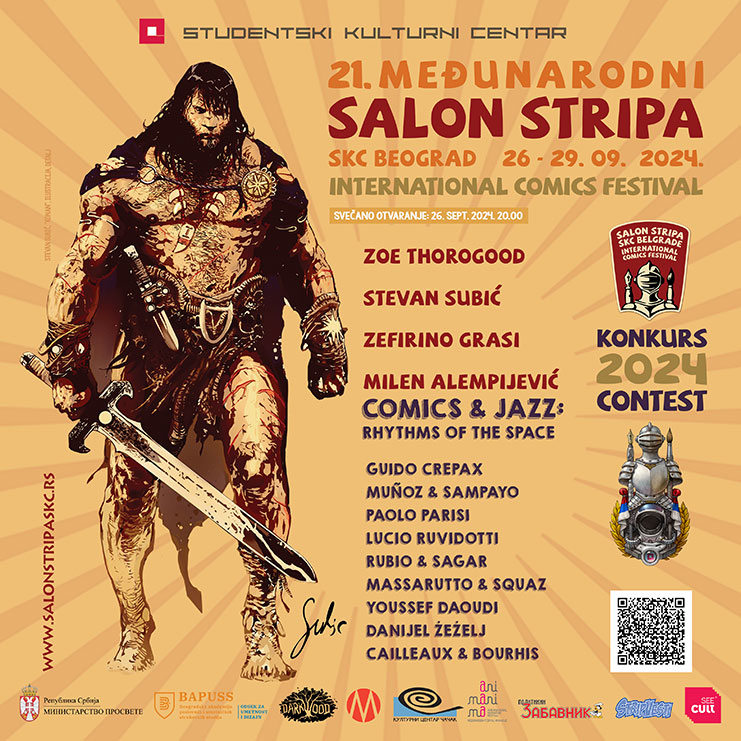GUESTS OF THE FESTIVAL 2024

GUESTS AND GUEST PROJECTS OF THE FESTIVAL
- MILEN ALEMPIJEVIĆ (RS)
COMICS & JAZZ: RHYTHMS OF THE SPACE, visiting project of the ANIMANIMA festival and the Cultural center Čačak, (GUIDO CREPAX, ALTAN, MUÑOZ & SAMPAYO, PAOLO PARISI, LUCIO RUVIDOTTI, RUBIO & SAGAR, MASSARUTTO & SQUAZ, YOUSSEF DAOUDI, DANIJEL ŽEŽELJ, CAILLEAUX & BOURHIS)
- ZOE THOROGOOD (UK)
Guest of Darkwood Publishing House
- STEVAN SUBIĆ (RS)
Main guest of the 2024 festival
- ZEFFIRINO GRASSI (RS)
Special award for general contribution to Serbian comics
MILEN ALEMPIJEVIĆ (RS)
COMICS & JAZZ: RHYTHMS OF THE SPACE
Visiting project of the ANIMANIMA festival and the Cultural center Čačak
GUIDO CREPAX, ALTAN, MUÑOZ & SAMPAYO, PAOLO PARISI, LUCIO RUVIDOTTI, RUBIO & SAGAR, MASSARUTTO & SQUAZ, YOUSSEF DAOUDI, DANIJEL ŽEŽELJ, CAILLEAUX & BOURHIS
The ambitious attempt by Daniel Sоutif, a philosopher, art historian, art and music critic, and an excellent connoisseur of jazz, to explore the multitude of communication codes between jazz and visual arts, resulted in the large exhibition Le Siècle du Jazz (The Century of Jazz) at the Quai Branly Museum in Paris in 2009. The catalog of that exhibition, as well as Sоutif's text Crepax, Pratt e altri solisti (Crepax, Pratt and Other Soloists) published in the Milanese magazine Musica Jazz the following year, were a direct incentive for research that led to our exhibition Comics & Jazz: Rhythms of the Space, premiering at the animation festival Animanima 2023 in the Cultural Center Čačak. Of course, one cannot overlook the significance of Jacques Bisceglia, a French jazz photographer and producer, who published an impressive amount of data related to the theme of jazz in comics in the column Le Jazz at BD in the magazine Le Collectionneur de bandes dessinées from 1986 to 2007.
Jazz has long found its place in film, always surprising both filmmakers and audiences with intriguing motifs and exciting narratives. However, can comics, as a visual medium expressed solely through static images, achieve the same or similar effects by reflecting an artistic form whose sole expressive medium is sound? Onomatopoeias in the form of graphemes, musical scores, song titles – instead of the sound of musical instruments? The sensitive matrix of space-time and the visual rhythm of comics perfectly communicate with the rhythmic patterns of jazz, two “phenomenologies“ merge into an almost spiritual amalgam that communicates with the viewer's most important inner space, where emotions and experiences condense in (un)predictable rhythms.
The exhibition Comics & Jazz: Rhythms of the Space attempts to prove this statement by opening up exciting worlds of significant authors, illustrators, and writers to the audience: A Man From Harlem by Guido Crepax, Rava Noir by Altan, Billie Holiday by Muñoz and Sampayo, Coltrane by Paolo Parisi, Miles: Assolo a fumetti by Lucio Ruvidotti, Miles et Juliette by Salve & Sagara, Mingus by Massarutto & Squaz, Monk! by Youssef Daoudi, Small Hands by Danijel Žeželj, and Piscine Molitor by Bourhis and Cailleaux. A valuable collaborator on the exhibition was Andrijana Ružić, an art historian living and working in Milan, the city where the magazine Musica Jazz is published and where Guido Crepax was born, thus closing the ‘energy circle’ that led to this small endeavor.
Milen Alempijević, exhibition author
STEVAN SUBIĆ (RS)
Main guest of the 2024 festival
Stevan Subić (1982) is a comics artist, graphic designer, illustrator, and scriptwriter from Zrenjanin. Since the age of nineteen, he has experimented with various artistic media, with his most notable work being the authorship of the radio show Muholovka (The Flytrap), which he edited from 2002 to 2008. At the same time, he was involved in organizing forums and concerts. He is the author of the Zrenjanin fanzine Žuta cigla (The Yellow Brick).
He has been involved in comics since 2009 when he won an award at the SKC Belgrade Comics Festival for his work Brooke Halabrin, consisting of four panels. Over the next three years, he created short comics that he showcased at regional and international comic events, winning the Grand Prix at the Genoa festival in 2011, chaired by Sergio Toppi. The following year, he began collaborating with the Italian publishing house Sergio Bonelli, for which he illustrated two volumes of the Adam Wild series, written by Gianfranco Manfredi, the comic Third Day, as the 65th issue of the Stories series, and the ninth album of the series Heartless. He made his debut on the French comic scene in 2015 with the tenth album of the series L'homme de l'annee. This was followed by the first two albums of the M.O.R.I.A.R.T.Y. series for Delcourt, The Cimmerian: Xhutal of the Dusk, written by Christophe Bec, for Glenat, and Tarzan, with the same writer, for Soleil. In 2021, he collaborated with the leading gaming company Blizzard on the Diablo 4 project.
In 2022, he began collaborating with DC Comics on the title The Riddler: Year One, written by Paul Dano, which garnered attention from the American comic scene. He continued his collaboration with DC Comics through work on The Penguin series with Tom King. So far, he has created over 20 covers for DC Comics on their leading titles, such as Batman, Superman, Detective Comics, Action Comics, Nightwing, Riddler, Penguin, Hellblazer, Swamp Thing, and others. In 2023, at the invitation of Jean-Pierre Dionnet, he wrote and illustrated a story for a special, anniversary edition of the legendary Métal hurlant.
He has had eight solo exhibitions and numerous group exhibitions. He has exhibited in Serbia, the region, and Western Europe. He is currently working on two new titles, of which more will be said after the official announcement by DC Comics.
ZOE THOROGOOD (UK)
Guest of Darkwood Publishing House
Zoe Thorogood (1998), a young comic book author and independent conceptual artist from Great Britain currently residing in Middlesbrough, attended game design studies at De Montfort University in Leicester. She made her debut in the world of comics in 2020 with her fanzine Angel and gained planetary popularity with the award-winning metanarrative autobiographical graphic novel It’s Lonely at the Centre of the World. Through suggestive and sharp dialogues, a raw but clearly defined authorial style that breaks the boundaries of the comic medium and rejects established conventions, she tells an intimate, embittered struggle against loneliness, depression, suicidal tendencies, and other dark afflictions brought by modern civilization. The therapeutic effect of working on comics, as well as the creative formation of her own procedure through various visual motifs or internal monologues reflecting her worldview, is also evident in The Impending Blindness of Billie Scott, a graphic novel with autobiographical tones inspired by the author’s long-standing vision problems.
Her collaboration with all major global houses (Marvel, DC, Titan, Image) followed. She illustrated, among other works, Rain by Joe Hill, contributed to the series Poppy’s Inferno, and was part of the team that worked on the anthology Haha (2021). She also conceived the character Spider-UK, the British version of Spiderman within the Spider-Verse multiverse concept.
The list of her awards is impressive. In 2019, she was honored with the title of Best Young Author (Comic Scene Awards). In 2020, her fanzine Angel won the award for Best Debut Title (Tripwire Awards). In 2022, Forbes magazine included her name in the list of the best graphic novels. The crowning achievement came last year - not only did she win in the category of Best Graphic Novel (Ringo Awards), but she was also nominated for the Russ Manning Award for Best Young Comic Artist. In the same year, she achieved something that no author of the ninth art has done before: she was nominated for the prestigious Eisner Award in five categories - best writer, artist, and graphic adaptation of memoirs - for her Lonely at the Centre of the World, and she was also nominated for best adaptation and drawing for Rain by Joe Hill.
As one of the greatest illustrators and artists of this decade, she has rightfully been called “the future of comics” and “the greatest hope of the ninth art”, although she already unquestionably represents the bright present of comics.
ZEFFIRINO GRASSI (RS)
Special award for general contribution to Serbian comics
Zeffirino Grassi, the son of two sculptors, a Swiss father, and a Serbian mother, saw the Belgrade sky for the first time on January 25, 1954, joining the celebration of the 50th anniversary of Politika on that day. He sped through primary school breathlessly, and at the Ninth Belgrade Gymnasium, to the dismay of his only surviving parent (he lost the other at the age of 8), he struggled with mathematics, physics, and chemistry, a struggle that, unfortunately, was passed down to his older son. His younger son, it seems, took after the other parent. Even in high school, he was poisoned by journalism thanks to two professors, Božidar Roganović and Milo Petrović, the first teaching him language and the second teaching him a worldview. In his youth, he was also a first-team player for the Red Star basketball club, playing in the shadow of greats like Cvetković, Simonović, Kapičić, Slavnić, Vučinić, Sarjanović, Rakočević, Pešić, Lazarević... He balanced a second-league basketball life with studies at the Faculty of Political Sciences, where he learned journalism from a master of the trade, Sergije Lukač.
From the end of 1977, he joined the ranks of young journalists, first at the daily newspaper Politika, then at Politika Express; and soon began his journey across Yugoslavia in the reporter's shoes of Ilustrovana Politika. His fateful meeting with Vlada Bulatović Vib, then the editor-in-chief of Politikin Zabavnik (Politika’s Entertainer), occurred one morning in late April 1985, while they were waiting for the elevator in the lobby of the Politika building. This great writer offered him a position at Zabavnik as his deputy. That was the beginning of it all, and it has continued to this day. He secured the best job in the world: the editor-in-chief of Zabavnik, in 1989, despite the opposition of Politika's then-director Živorad Minović. For once, workers’ self-management prevailed as the entire editorial staff stood by Grassi. He endured the 1990s struggling to preserve Zabavnik, using all possible, permitted, and less permitted, means. This century brought him two changes: he gained sons and the position of director of Politika from 2011 to 2022, while still working at Zabavnik.
He has received two awards: the Karić Brothers Foundation Award (without a monetary prize) and the Golden Badge of the Cultural and Educational Community of the Republic of Serbia.
He is still alive and editing Zabavnik.



